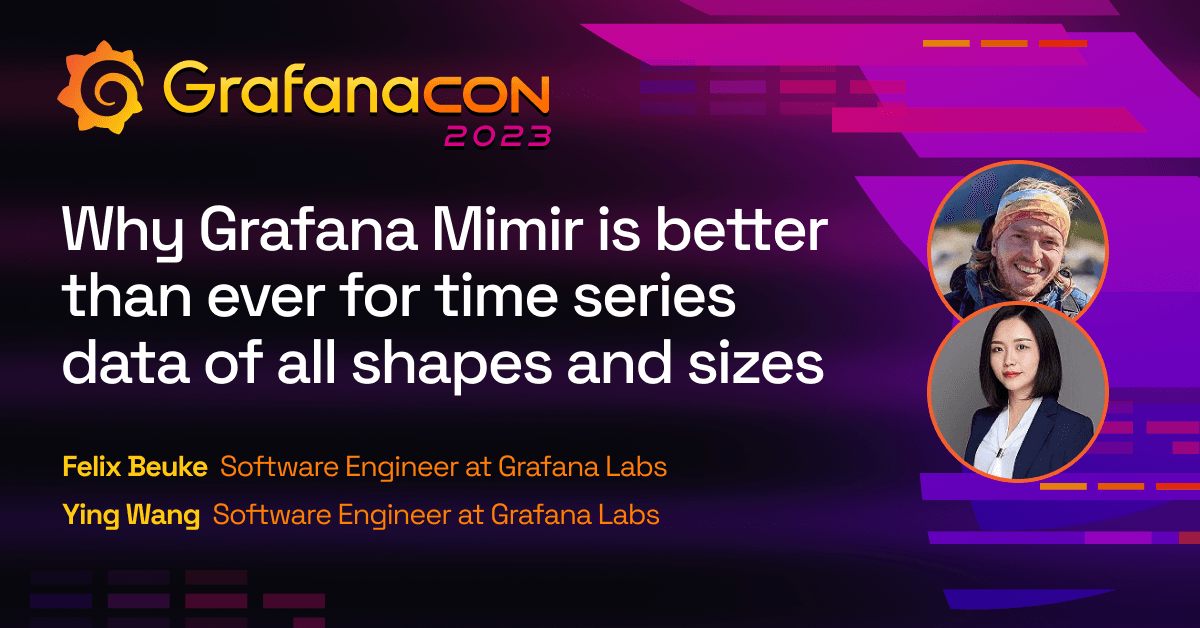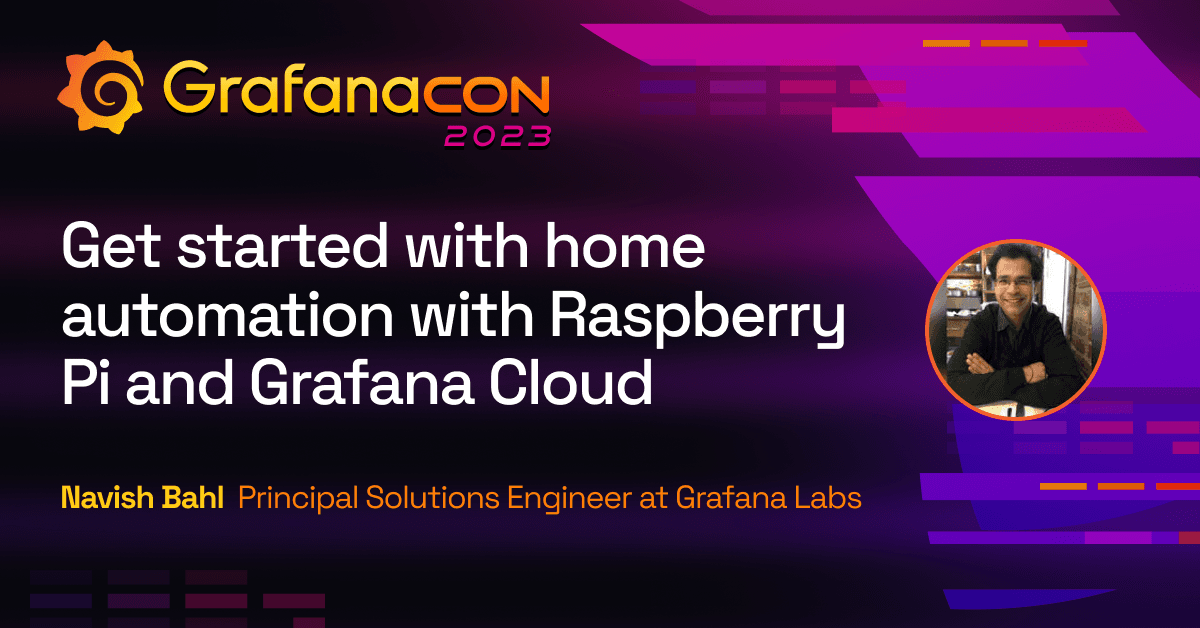GrafanaCON 2023 Day 2 Recap: A Grafana 10 deep-dive, Grafana Tempo and Mimir updates, home automation, and more
Today marked the second full day of GrafanaCON 2023, and all the excitement from yesterday certainly did not wane. Attendees and speakers alike continued to buzz about the Grafana 10 release — and so much more.
In addition to a detailed demonstration of our latest major release, day two of GrafanaCON covered recent updates to Grafana Tempo and Grafana Mimir, provided a closer look at Grafana Scenes, and even explored how to use Grafana dashboards to optimize home automation or win big in your next triathlon.
If you couldn’t tune in, here’s a look back at all the action from day two. All GrafanaCON 2023 sessions will also be available on-demand.
Deep dive into Grafana 10
This session provided GrafanaCON 2023 attendees with an in-depth look at Grafana 10.
“We’re excited to share Grafana 10 with you,” said Quynton Johnson, Senior Product Marketing Manager at Grafana Labs, to kick things off. “This release encapsulates our dedicated team’s hard work, innovative thinking, and relentless commitment to improvement. It marks an evolution of Grafana that we believe will open up even more possibilities for you to visualize your data.”
Johnson was joined by fellow Grafana Labs team members Fabrizia Rossano, Senior Product Manager; Kristina Durivage, Senior Software Engineer; and Mitch Seaman, Director of Product, who explored the new features, functionality, and ease-of-use improvements in the latest major release. These exciting additions and enhancements include updates to the Grafana as code experience, new capabilities for incident response and data correlation, and Grafana Scenes, a new frontend framework for dashboards that is more flexible and interactive than ever before.
Access the on-demand session here.

Monitoring high-throughput real-time telemetry data at Daimler Truck with the Grafana Stack
To offer its customers state-of-the art digital services, Daimler Truck manages anonymized data from more than 8,000 connected buses operating in Europe using the cTP, an installed piece of technology that streams telemetry data (such as vehicle speed, GPS position, acceleration values, and braking force). The throughput going through the system is around 300k messages per second, or around 7MB at peak, on an average latency of around 5 seconds between the vehicle and when the data is available for consumption.
This entire trove of data requires services that ingest, store, process, analyze, and feed connectivity services (such as fleet management systems, vehicle insights, and driver grading).
These services run in a Kubernetes environment and are monitored in near real-time via a stack built with Grafana, Grafana Loki, Prometheus (leveraging Grafana Mimir), and Pyrra. Needless to say, all of these services need to be highly available, and their own response and latencies have to be as low as possible.
In this session, Principal Engineer of tb.lx by Daimler Truck, Adrien Bestel, demonstrated how they run in three environments (dev / int / prod), with three separate Grafana instances, and drive automation via Grafana APIs to synchronize their dashboards and promote them between environments. On top of that, they discussed how they use SLI and SLO metrics from within Grafana to track the team’s uptimes and service levels.
Access the on-demand session here.

What’s new in docs: improvements, how to contribute, and more
In this session, members of the Grafana Labs technical writing team explored the world of docs, including highlights such as the Writers’ Toolkit for contributing content, improvements to the docs site design, updates over the past year, and future plans.
Access the on-demand session here.

How to build dynamic, customizable dashboards with Grafana Scenes
In this session, Grafana Labs engineers Bogdan Matei and Dominik Prokop demonstrated how the new Grafana 10 feature, Scenes, transformed how they built the Grafana Cloud Application Observability app. The app started as a regular Grafana plugin that provided a couple of custom-built dashboards and panels dedicated for user applications, but Grafana Scenes took it to the next level, allowing the team to build a dashboard experience with greater flexibility and control.
“Scenes is a new library that makes beloved dashboard features available to plug-in developers,” Prokop said. “Grafana Scenes provides out-of-the-box support for familiar things like panels rendering and grid layout, data querying and transformations, variables and time ranges. With just a few lines of code, you can bring dashboard-like experiences directly into your app.”
During this session, attendees learned how, exactly, Scenes can streamline the creation of dashboard-like apps so they can focus more on the data they want to visualize.
Access the on-demand session here.

How Grafana and Tempo 2.0 make it easier to explore distributed traces
Tempo 2.0, complete with the brand new TraceQL query language, is here! In this session, attendees learned how to get the most out of the open source distributed tracing project’s latest major release.
First, Software Engineer Zach Leslie shared what his team has learned running Grafana Tempo at massive scale to power Grafana Cloud Traces — and how you can turn those learnings into best practices for operators.
Then Tempo maintainer Joe Elliott shared tips and tricks for using TraceQL to find and visualize “needle in the haystack” traces, and explained how Tempo 2.0 leverages Apache Parquet and massive parallel processing to answer queries extremely quickly. Attendees walked away with foundational knowledge that will help them write more efficient TraceQL queries.
Access the on-demand session here.

How Grafana k6 helps you break your APIs to make them stronger
In this session, Jose Luis Latorre Millas, Software Architect & Developer Community Lead at SwissLife AG, explained why regularly breaking your own APIs is the best way to make them stronger.
“Breaking your API is the best way to discover how to find issues in your software that can only be found in production,” said Latorre Millas. “What does that mean? If you don’t test in a proper way, doing stress or performance testing, you are not going to find certain kinds of issues, or it will be very, very hard.”
Using Grafana k6 for performance testing, Latorre Millas discussed what metrics to check, what to test, and best practices for getting it done. Attendees learned how to implement k6 tests and run them against test-ready APIs hosted on Azure App Service, expand from a simple k6 test into a full-fledged performance test, and then interpret the results with built-in k6 Cloud visualizations.
Access the on-demand session here.

Grafana’s new navigation: A journey of user experience, design, and continuous improvement
This session covered the evolution of Grafana’s navigation, from user research to design to release. Attendees gained insights into the important measures Grafana Labs engineers took to improve both usability and scalability within the new navigation experience.
“Similar features have been grouped together, so you can quickly move between your Grafana OnCall schedule, your alerts, and your incidents, for instance,” explained Yaëlle Chaudy, Engineering Manager at Grafana Labs. “The navigation will also remember which sections you have open, and which ones you do not, so the menu can adapt to your specific usage.”
Chaudy discussed the team’s dedication to continual improvement and user-focused design, and how they combined these efforts to bring you Grafana 10.
Access the on-demand session here.

Why Grafana Mimir is better than ever for time series data of all shapes and sizes
A lot has happened in the year-plus since the launch of the open source TSDB Grafana Mimir. In this session, Grafana Labs software engineers Felix Beuke and Ying Wang walked through the major developments — backfill of historic data, native histograms, Helm chart investments, memory and performance optimizations, and more — that make Mimir ideal for both your DIY project and an industrial-scale data center.
Beuke and Wang also spoke about their ongoing efforts to align Mimir with the open source observability ecosystem, citing capabilities for native OpenTelemtry ingestion as one recent example of this commitment.
Access the on-demand session here.

Automated performance modeling with NASA Open MCT, Grafana Cloud, and k6
The frontend has traditionally been the bearer of bad news when it comes to underlying system performance problems. Backend fixes are put into place just as the frontend moves the goalposts. Using tools like k6 and k6-browser make it possible to keep your frontend performance tooling in sync with the backend performance and in step with feature development.
In this live demo, John Hill, Web UI Test Engineer, KBR Inc. at NASA Ames Research Center, used Grafana k6, k6-browser, and NASA Open MCT to show how to combine frontend and backend performance modeling tools. He detailed frontend performance modeling strategies to keep the feature development teams in sync with the performance tests. Lastly, he discussed how the Grafana and k6 ecosystems can be used to ensure performance in mission-critical applications like NASA’s Open MCT.
Access the on-demand session here.

Get started with home automation with Raspberry Pi and Grafana Cloud
The universe of home automation is ever expanding, and this session will help you take baby steps to get started visualizing and monitoring your home with a few smart devices, some which you may already have around the house. Principal Solutions Engineer Navish Bahl demonstrated what he’s achieved using Raspberry Pi, Grafana Cloud, a Ring home security system, an Ecobee thermostat, two smart power plugs (powering TVs), a home router, an HP printer, a Macbook, and even his wife’s blood sugar monitor. He walked attendees through the hardware prerequisites that are necessary to create these unique home automation visualizations, as well as important architectural considerations.
“I’m letting you walk from setting it up from ground zero all the way to having beautiful Grafana dashboards,” Bahl told attendees.
Access the on-demand session here.

Using Prometheus, Python, and Grafana Cloud for data-driven triathlon training
Kyle Shelton, Senior DevOps Engineer at Toyota Racing Development by day and triathlete in his free time, knows the power of Grafana. He relies on being data-driven to perform both on and off the track.
During this session, Kyle demonstrated how he uses generative AI to write Python scripts that pull data from fitness APIs like trainingpeaks, as well as how Grafana Cloud and Prometheus can be used to create custom dashboards to monitor your progress. He shared tips and tricks for taking advantage of Grafana’s composable nature to build useful dashboards for personal and professional projects.
Whether you’re a seasoned athlete or just starting out, this session was sure to rev up your dashboard game.
Access the on-demand session here.



